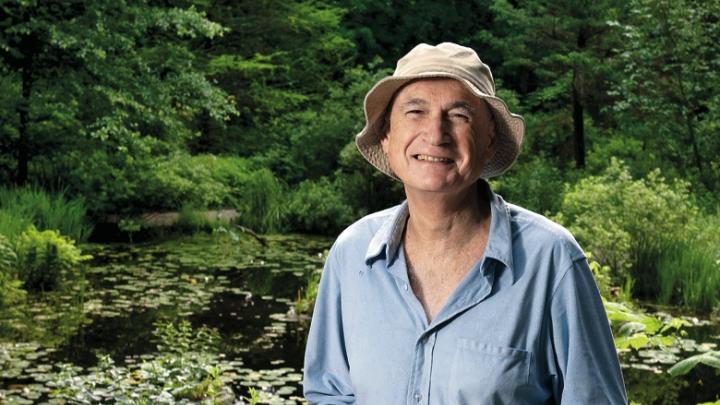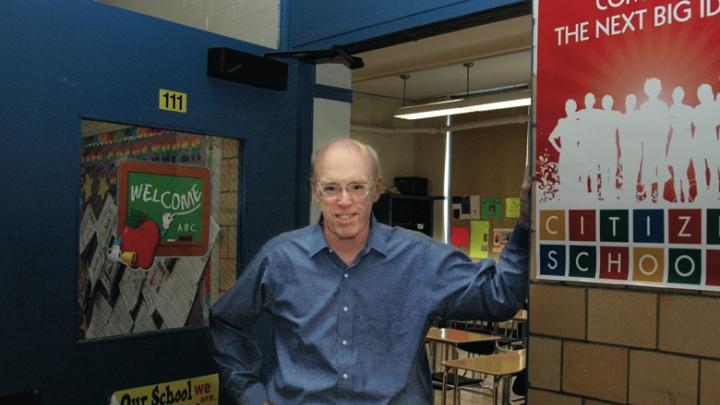“How can anyone not fall in love with a trillium?” asks Al Levin ’56, M.D. ’60, stopping to cup a starry white blossom while showing a visitor around Garden in the Woods, a trove of native plants. “These spring ephemerals thrive on early light and flower before the trees leaf out—and then they are gone.”
For 30 years, Levin has visited this “magical fairyland,” owned by the New England Wild Flower Society, in Framingham, Massachusetts. Now that he is semiretired from a career in cardiology, his volunteer post as a garden guide lets him delve more deeply into interests shelved while working. “In a very self-indulgent way,” he explains, “I’ve been able to renew my love affair with the outdoors—gardening, horticulture, botany—and the whole natural world.”
Older people with newfound time on their hands have multiple personal reasons to volunteer for a worthy cause. Some, like Levin, seize the chance to reinvigorate dormant passions and continue their education; others volunteer to increase their social or political engagement and/or get out and meet new people. For many, however, donating skills to a cause is simply a satisfying way to “give back.” “Writing a check is important, but most of us are in a position to make a greater aggregate contribution with our efforts than with our money,” says Boston attorney R. Newcomb Stillwell, J.D. ’84, chairman of the board of the Massachusetts chapter of Volunteers of America, which runs a variety of social programs. “There is no question that the more involved I am as a person, the more rewarding the work is.” Stillwell, who also serves on the board of Cradles to Crayons, which collects clothing, toys, and equipment for poor children, and has a family himself, puts in an average of four volunteer hours a week. “I enjoy working on problems and helping to manage organizations,” he says. “I hope when my kids grow up and move out that I have more time for this work in retirement—it’s fun.”
Nationwide, about 61.8 million, or 26.4 percent of the adult population, volunteered at least once between 2007 and 2008, according to data collected by the Bureau of Labor Statistics. Volunteerism among adults overall has risen since such numbers were collected in 1974 and in 1989—peaking post-9/11 before declining somewhat during the last five years.
A renewed national push through the Obama administration’s United We Stand initiative (www.serve.gov) and the funding of the Hatch-Kennedy Serve America Act that passed in April could start to boost those overall volunteer rates again. Helping out will be the Corporation for National and Community Service, the federal agency that supports and promotes volunteerism. Created in 1993, the 600-employee corporation supplies grants and infrastructure for mobilizing volunteers and also runs several programs, such as Senior Corps, AmeriCorps, and Learn and Serve America.
“Everybody is for service; the question is how government should participate,” says the corporation’s vice chair (and former chair) Stephen Goldsmith, Paul professor of government and director of the Ash Institute’s Innovations in American Government Program at the Harvard Kennedy School. “I have worked over the years to find a point of agreement, which includes investing in a governmental infrastructure that manages service”: for example, by interviewing volunteers, coordinating programs and placements, making the work meaningful, and measuring progress and accountability.
Goldsmith, a former mayor of Indianapolis, was instrumental in passing the Hatch-Kennedy Act (it expands volunteer opportunities, among other things). He continues to push for novel solutions to social problems, largely through the Executive Sessions on Transforming Cities through Civic Entrepreneurship, which bring academics and civic leaders together in a think-tank environment.
Public service in America is especially critical now, he points out, given the serious needs of families in crisis: “No matter how much money we spend, the numbers and problems exceed the monies available.” On the plus side, he adds, the Obama administration has put its weight behind public service as a movement, while the concurrent rise of social networking tools makes it easier to mobilize large groups of constituents—and for them to learn of events and join friends to volunteer together. Moreover, Goldsmith says, two fertile demographic bubbles portend increased public service: the post-9/11 generation, which has record-high rates of community involvement, and the baby boomers, “who are the healthiest generation to retire in the history of the nation and interested in remaining active after retirement.”
Tony Helies, M.B.A. ’74, is one prime example. An entrepreneur in high-tech ventures who began his career as an engineer for the Apollo program, Helies teaches astronomy to middle-schoolers through Citizen Schools (www.citizenschools.org), a Boston-based organization that runs after-school enrichment programs around the nation with volunteer teachers—many of whom are retired professionals over the age of 50. Helies says he devoted most of his life to work and family, “so when I decided I wanted to give back, I focused on the K-12 education and began working in the Boston schools 10 or 12 years ago.” Why schools? Because growing up in Brooklyn, Helies earned a scholarship to the prestigious prep school Trinity, in Manhattan, and then went on to college and business school “and got the chance to do some pretty neat things in life that were lucky for me,” he says. “But it all hinged on education.”
Helies began consulting pro bono on issues concerning policy for and governance of charter and pilot schools. He still does that, but when he became curious about “customers,” he moved right into the classroom, where he teaches the ancient Greek techniques for measuring parts of the solar system. Outside on a sunny day, he and the kids use a pinhole camera made out of a shoebox to project the sun’s image and calculate its size. “My happiest day is when the kids don’t believe me and challenge the experiment and ask a lot of questions,” he says. “Unfortunately, that’s not the culture that exists in most public schools, but I try to get them going.”
Baby boomers are proving to be an interesting cohort of volunteers not only because of the sheer size of the group (and its potential, therefore, to effect change), but because of the high level of education and skills they offer organizations.
What’s also interesting is how nonprofits and the volunteer system are starting to shift to meet boomers’ requirements. “We’re finding that there is a segment of boomers who do not want to be considered traditional volunteers,” says Mal Coles, Atlantic area manager for the Corporation for National and Community Service. “But if you want to call them ‘pro bono consultants,’ then maybe they would consider the job. These are well-educated folks with successful careers who are choosy about how they want to invest their time; they are credentialed, used to being engaged at a high level, and they want to make an impact.”
Civic Ventures in San Francisco (www.civicventures.org), for example, is a novel organization that specifically targets baby boomers who want to put their abilities to good use in the second half of life. Its Encore Fellowships generally offer paid, one-year leadership positions with nonprofit and public-sector organizations to foster volunteers’ transitions to new post-mid-life service careers.
Even though the rate of volunteerism among older adults (baby boomers and those over 65) has declined during the last five years, boomers on the whole are still serving at significantly higher rates than the previous generation did at their age, says the corporation’s Robert Grimm. This activity is tied to their education levels, the fact that they had children later in life (parents tend to volunteer the most), and the fact that boomers are working more later in life. “Continuing to work is a predictor because volunteering is about social networks,” Grimm says.
Yet these same qualities can engender a sense of self-worth that can make placement in traditional volunteer roles complicated. The conventional service opportunities still exist, and are critical—jobs like driving elders to appointments, delivering meals, working in hospitals, participating in phone banks, and stuffing envelopes. This type of service is attractive to people who want straightforward tasks that contribute to the common good—and also have finite hours and obligations. But increasingly, especially in the Northeast corridor, Coles says, “a lot of high-end boomers consider their contribution valuable, and are savvy enough that if organization X doesn’t appreciate them, then they can go somewhere else.”
This need to find “the right fit” means that organizations in need of volunteers must approach this group more as regular employees in terms of management, training, performance, talent use, accountability, and incentives, Grimm explains: “Leaders have to take a broader view of how they can apply skills and assets in their organization and re-think the paradigm about what staff can do and what volunteers can do.”
Coles says there is a “fear factor” on the part of some institutions about letting in volunteers who want to be part of the decision-making—even tension around “welcoming that high skill set. But the smarter nonprofits look at the whole mosaic of the human capital at their organization and figure out how to synchronize it.”
Eric Schwarz, Ed.M. ’97, founder, president, and CEO of Citizen Schools, agrees. “Boomers have the potential to revolutionize the nonprofit sector if organizations can integrate the wealth of knowledge and experience of this volunteer group,” he explains. “They are looking for long-term opportunities where they can dig into a substantial, high-impact project.” The organization recently completed a study of its 55-and-older volunteers’ engagement, and identified strategies for attracting and retaining that population—in part by partnering with groups like AARP, Civic Ventures, RSVP (the federal corporation’s volunteer network), corporate and university retirement programs, and senior centers.
Such attention to the talent pool seems to have paid off with Helies, who thinks Citizen Schools “is a pretty good model,” mixing some elective courses, like cooking, in with the heavier-duty-content courses like astronomy. He also tutors youngsters in advanced math. “A lot of these kids have been math cripples and taught to be comfortable with average results,” he says. “But with these kids—it blows your mind what they’re really capable of and gives you insight into what we can do when we’re really pushed.”
Like most volunteers, he appreciates the chance to experience such interactions, and the organizations that facilitate them: as he notes, “Citizen Schools can give you a venue and opportunities to share something you know.” And everyone, he adds, “knows something they could teach a kid.”








